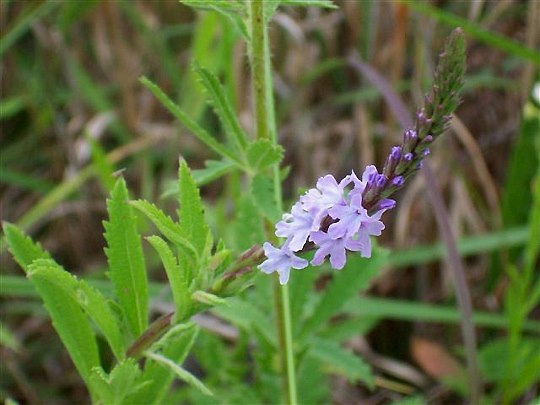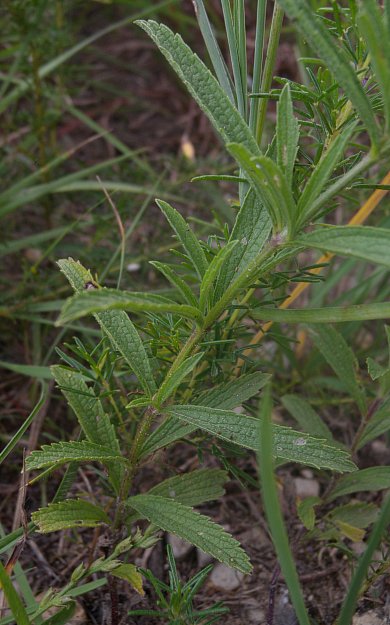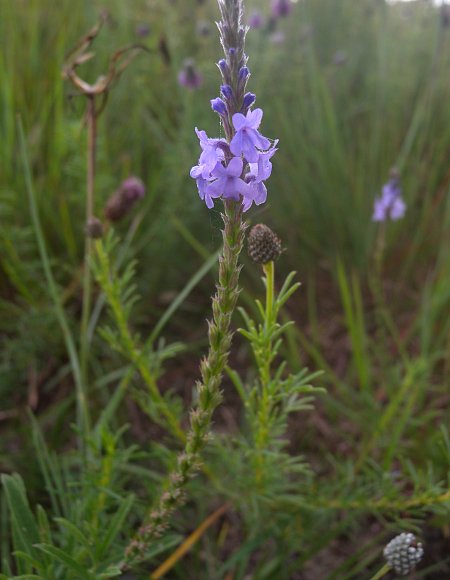Description: This herbaceous perennial wildflower is ¾-2½' tall and ascending to erect. It often branches near the base, while above it is unbranched or sparingly branched. The stems are glabrous or short-pubescent; pairs of opposite leaves occur at intervals along these stems. The narrow leaves are 1¼–4" long and less than ½" across; they are narrowly oblanceolate or narrowly elliptic in shape and smooth to coarsely toothed along their margins. There are more teeth toward the tips of the leaves than at their bases. The leaves taper gradually into petiole-like bases. Their upper surfaces are pale to medium green and glabrous or sparsely short-pubescent.

The stems
terminate into spike-like racemes of flowers about 4-12" long; there is
only one raceme per stem. Only a few flowers bloom at the same time,
beginning at the bottom and ending at the top of each raceme.
Individual flowers are up to ¼" across, consisting of a lavender to
nearly white corolla with 5 spreading lobes, a short tubular calyx with
5 teeth, 4 inserted stamens, and a pistil with a single style. At the
base of each flower, there is a lanceolate leafy bract that is about
the same length or a little shorter than the calyx. The blooming period
occurs during the summer for about 2 months. Afterwards, the flowers
are replaced by nutlets (4 per flower). These nutlets are oblongloid,
somewhat flattened, and about 1/8" long.
Cultivation:
The preference consists of full sun, dry-mesic to dry conditions, and
gravelly alkaline soil. Sandy soil is also acceptable if it isn't too
acidic.

Range &
Habitat:
The native Narrow-Leaved Vervain is occasional throughout Illinois (see
Distribution Map).
Habitats
include dry gravel prairies and dolomite prairies, hill prairies,
limestone glades, gravelly areas along railroads and roadsides,
abandoned fields, and barren waste areas. This species prefers sunny
areas with scant vegetation.
Faunal Associations:
The flowers attract bees, skippers, and probably butterflies. Robertson
(1929) observed little carpenter bees (Ceratina sp.),
cuckoo bees (Epeolus sp., Coelioxys sp.),
leaf-cutting bees (Megachile sp.), green metallic
bees (Augochlorella sp.), and the Silver-Spotted
Skipper (Epargyreus clarus) visiting the flowers for
nectar. Two oligophagous insects, Crambodes talidiformis
(Verbena Moth) and Macrosiphum verbenae (Verbena
Aphid), feed on Verbena spp. The seeds are a minor
food source for the Lark Bunting (in the Great Plains) and several
native sparrows that prefer open habitat.

Photographic
Location:
A prairie in Fayette County, Illinois, and a gravel hill prairie in
Cook County, Illinois. The photograph of the flowering
plant with lighter flowers and leaves was taken by Keith &
Patty Horn (Copyright © 2009), while the remaining photographs were
taken by webmaster.
Comments:
Narrow-Leaved Vervain can be distinguished from other Verbena
spp. by its narrow leaves (less than ½" across) and long
slender spikes of flowers (actually, spike-like racemes because the
flowers have short pedicels). Its flowers are smaller in size than
those of Verbena stricta (Hoary Vervain), but
larger in size than other Verbena spp. within the
state. This comparison excludes Rose Vervain, which has been reassigned
to a different genus (Glandularia). Narrow-Leaved
Vervain can form hybrids with other species in its genus. Two of these
hybrids have been found within the state: Verbena ×
blanchardii (with Verbena hastata) and Verbena
× moechina (with Verbena stricta).